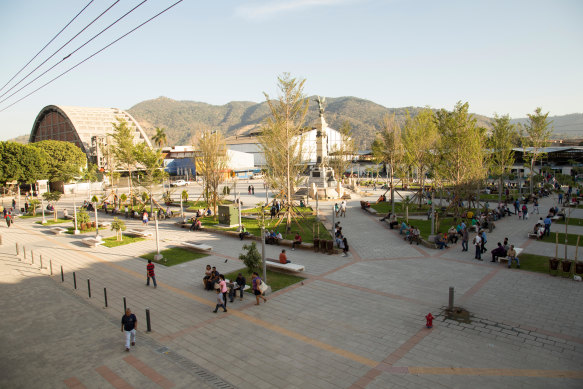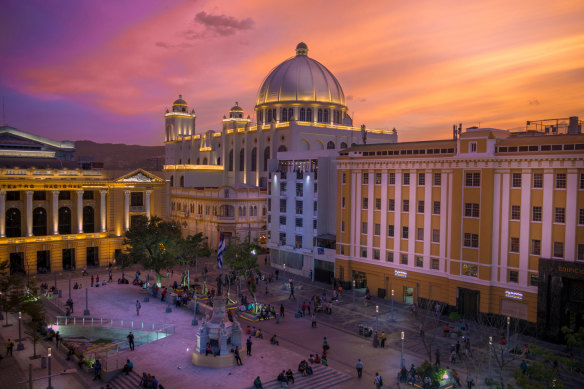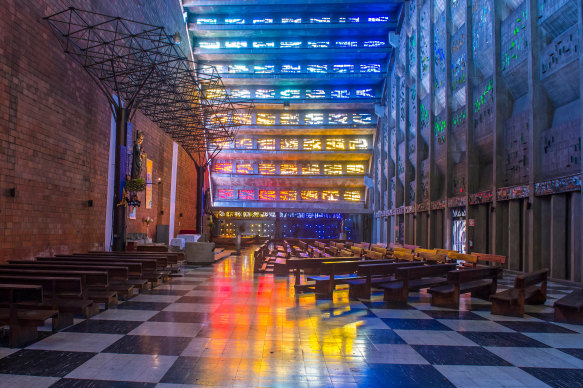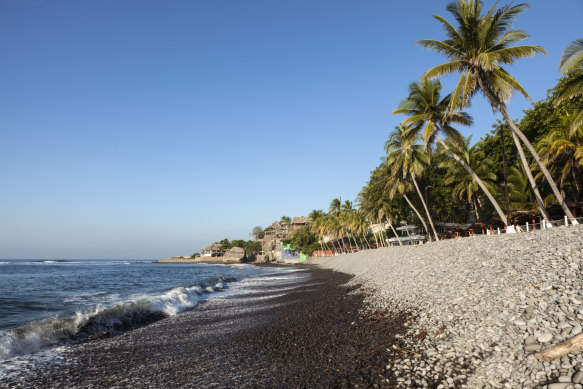This notorious country now deserves to be on your travel radar
The factions stare each other down across Liberty Plaza. They gather in splotchy shade, sanctuary from the vexatious midday sun which sears the already well-faded colonial ostentatiousness of central San Salvador, the notorious capital city of El Salvador, a country seemingly synonymous with notoriety.

The gangs that frequent Liberty Plaza in San Salvador now wield musical instruments, not guns.Credit: Alamy
The upcoming battle, however, subverts the basket-case narrative of this tiny Central American pariah, which sits on the Pacific Coast below Guatemala. Powwows of humans dressed with no regard for Western trends wield unwieldy vintage instruments; well-lacquered double basses, tarnished trumpets, thoroughly beaten drums, family heirloom accordions and a prolific consort of xylophones.
Bands flourish to life organically. Stranger dances with stranger. If the tempo dips, the crowd swarms across the square towards a brighter musical light. A squat gentleman in a white cowboy hat, intermittently playing his fiddle with ringed fingers, asks me how I like ‘El Folkorico’ music. It seems to be a pastiche of El Salvador’s human history; its Spanish conquerors, the African slaves forced to toil for them, the enduring Indigenous people at its heart.
This unheralded battle-of-the-bands is not a cynical show for foreign tourists – there aren’t enough of us here yet to bother. Five years ago, San Salvador was statistically the most murderous city in the most murderous country on earth, more likely featured on Vice News than travel pages.
For years, El Salvador has been at the mercy of two rival gangs: MS-13 (Mara Salvatrucha) and Barrio 18. Both emerged on the streets of Los Angeles; their ranks originally filled with Salvadorans fleeing the civil war that rampaged from the late 1970s to early 1990s. Gang members were mass-deported back to El Salvador in the early-2000s.

San Salvador’s historic centre.Credit: iStock
Arguably once more powerful than the government, the criminal gangs have recently hit a brick wall by the name of Nayib Bukele, elected as president in 2019 on an anti-gang platform. After a particularly deadly day on the streets in early 2022, the controversial young leader declared a 30-day régimen de excepción (state of emergency). Mass arrests followed, resulting in tens of thousands of alleged gang members being jailed, often sans trial.
Critics of the self-professed “coolest dictator in the world” claim mass human rights violations – including deaths in custody – while Bukele supporters say the crackdown has decimated gang violence, intimidation and dramatically reduced the murder rate. Eighteen months later, the state of emergency is still in place, so is this former destination-non-grata open for tourism? Well, officially it never closed.
Like any big city in Central America, San Salvador especially can be intimidating, tinselled in razor wire and patrolled by security forces toting big-game shotguns. But travelling in this city and country is certainly not a “hard no” anymore.
In daylight hours, the capital’s Centro Historico feels energetic and well, normal. Old men sit around televisions watching football played afar and young folk hang out at mobile phone shops scored by thumping music.
The police presence is over-compensating-ly visible. The tourism police stop me for a chat, seemingly out of curiosity and/or boredom, then wish me a buen dia. People on the street look at me without looking at me because they still don’t see too many tourists, thanks to the city’s unshakably dire reputation.

Iglesia El Rosario is unlike any church in Central America.Credit: Alamy
Yet volcano-fringed San Salvador offers a compelling handful of museums and galleries, an animated central market, and an evolving cafe scene (around Colonia Escalon). Some say the lively Zona Rosa bar scene lost its verve during the dark days but many more say that it’s in full-blown renaissance.
San Salvador’s churches harbour captivating chapters of modern history. Underneath the Cathedral of San Salvador lies the tomb of Catholic Archbishop Oscar Romero, killed during mass because he criticised civil-war authorities.
Rubén Martínez Bulnes-designed Iglesia El Rosario is unlike any church in Central America. The brutalist concrete exterior, still pockmarked with civil-war bullet-holes, contrasts kaleidoscopically with its cavernous interior, illuminated by a trippy rainbow arch of stained-glass.

Playa El Tunco is courting America’s surfers.Credit: iStock
El Salvador’s biggest drawcard is the dark-sand beaches, point-breaks and hammocks of La Costa El Balsamo. Fast-developing Playa El Tunco is the ‘cool’ scene but further north – heading towards El Sunzal and El Zonte – beaches and villages become less crowded, meaning more waves and mangoes for you. The hippy-surf vibe is changing fast, however, as authorities have begun rebranding the area ‘Surf City’ to wow the US mass market.
Ruta de Flores (flower route) cuts a lovely road trip through El Salvador’s interior, pit-stopping at coffee towns in the shadows of the giants of Parque Nacional Los Volcanes. (Hikers note: Santa Ana volcano, 2381 metres, best reached from the eponymous city to the north, is a wonderful day-hike).
While a great cup of coffee can be strangely hard to track down in the rest of El Salvador (despite its high-quality beans), Ruta de Flores towns like Ataco and Juayua hold much joy for caffeine-lovers. Another should-do town is Suchitoto, north-east of San Salvador, on the banks of man-made Lake Suchitlán. It’s a cobbled-street mini cultural capital, featuring pastel houses and a flourishing arts and handicrafts scene.
Generally, travelling around tiny El Salvador is relatively frictionless. Crossing over from Guatemala to the town of Cara Sucia (literally ‘dirty face’) is a piece of cake compared with most land borders in Central and South America.
If you don’t fancy using the ridiculously cheap but sometimes difficult-to-decipher chicken-bus network (a lot less rough than the reputation, and with fewer chickens), there is a plethora of good-value private car tours and transfers. Uber is a safe, reliable and cheap option, too – about $US20 ($A30) for the one-hour trip between San Salvador and the coast.
While Salvadoran cuisine is no Mexican fare, low-spice street food such as the ubiquitous pupusa – a grilled, filled rice flour/cornmeal flatbread – and the smoothie-like licuado are tasty sustenance indeed.
Extreme crime fighting hasn’t been president Bukele’s only controversial move. He introduced Bitcoin as El Salvador’s second official currency in 2021 (underneath the US dollar), a move some argue will further damage a knife’s-edge economy which already heavily relies on remittances from two-million Salvadoran expats in the US.
So, is El Salvador safe? Since November, it rates an “Exercise a high degree of caution” on Smartraveller, with warnings over the ongoing state of emergency and risk of violent crime. But, for context, Indonesia, India and Thailand currently have the same warning.
I won’t insult your intelligence with a “I had no problems in two weeks, so it’s fine” line but I will share some on-ground observations. Like any country, it’s your responsibility to read the current political situation before booking a trip and listen to trusted locals when they say where to go and where not to – especially at night!
Right now, it’s a surreally serene place to travel through, almost as if it’s in the eye of a storm that could blow either way. I felt a genuine outpouring of optimism from people desperate to shed their long-worn coats of pessimism. Many Salvadorans proudly told me that their country is a safer place under the new regime. One poll suggests 92 per cent of people have a “favourable opinion” of Bukele, even as Western observers keep flying red flags.
Ironically, El Salvador translates from Spanish as “the saviour”, but time will tell if this country – with all the highlights of celebrated neighbours like Guatemala and Mexico’s Yucatan Peninsula – has truly turned a corner.
If you hate crowds, don’t mind a bit of adventure, and love beaches, Mayan ruins, colonial cities and volcano hikes, then El Salvador should, at the very least, be on your travel radar.
THE DETAILS
Fly
United Airlines flies from Sydney to San Salvador via Houston or cross land borders with the CA-4 tourist card as above.
Visit
A tourist card costs $US12 on arrival, allowing 90 days in El Salvador and ‘CA-4’ countries: Guatemala, Honduras and Nicaragua.
More
For security updates see smartraveller.gov.au
The writer travelled at his own expense.
Sign up for the Traveller Deals newsletter
Get exclusive travel deals delivered straight to your inbox. Sign up now.